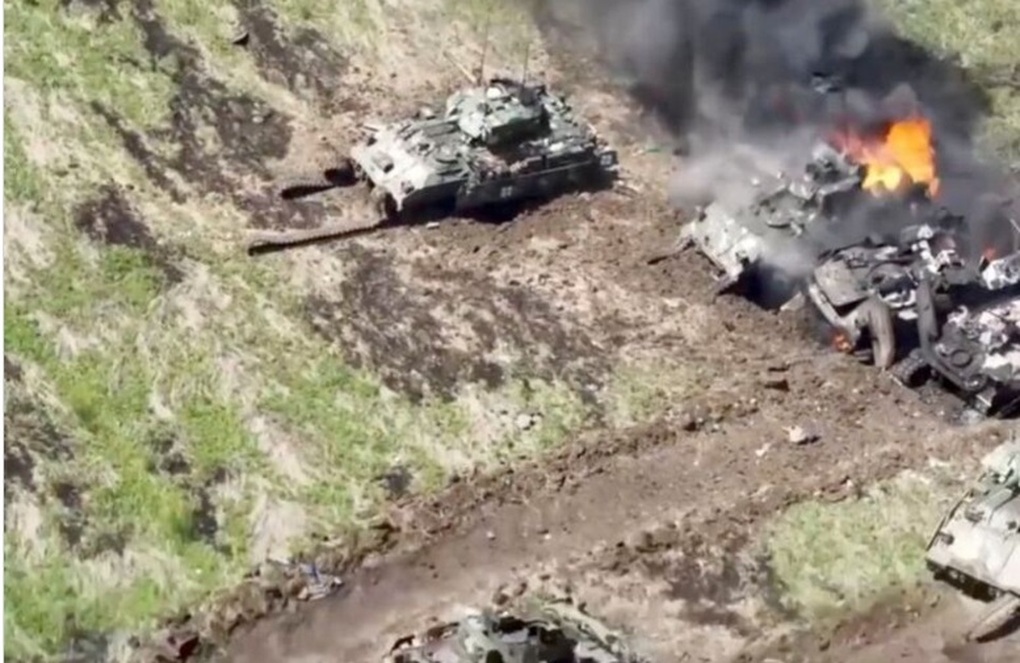(Dan Tri) – Ukraine has had some significant breakthroughs in the counterattack, but is struggling in dense minefields and was stopped early by Russia with artillery, air force and suicide UAVs.
Ukrainian tanks participate in the counterattack campaign (Photo: Domena publiczna).
One of the reasons why Ukraine suffered heavy losses in the counter-offensive campaign was the presence of dense minefields arranged by both sides to prevent the enemy from breaking through.
In fact, Russian minefields have left Ukraine with very few tactical options when attacking and can be defeated when discovered by Russian reconnaissance vehicles, giving targets to artillery and autonomous UAVs.
It is impossible to move forward without sweeping mines
Along the front line from Zaporizhia to the Donbass region, the biggest obstacle that Ukraine needs to overcome first are the dense minefields arranged by Russia.
Most of this area has flat terrain with few natural obstacles, so the minefields arranged by Russia often anticipate Ukraine’s attack direction, in front of the settlements and tactical high points.
However, Ukraine is seriously lacking special minesweeping vehicles to pave the way for mechanized advancement.
Russian reconnaissance operates 24/7, regularly detects enemy activities early, indicates targets for artillery to intercept, and conducts many remote raids, right in the area where Ukraine gathers troops before maneuvering to attack.
There were also Ukrainian attacks that were able to overcome the minefield but were unable to penetrate deeper because they were blocked and fiercely fought back by Russian mobile forces equipped with powerful anti-tank weapons.
Ukrainian combat vehicles easily lose formation and may have to leave the safe corridor previously created by mine-clearing vehicles, only to fall into Russian minefields and cause great damage.
It is not difficult to find images of Ukrainian armored forces being damaged by mines and then becoming immobile targets for Russian artillery and anti-tank weapons to attack and completely destroy.

Ukrainian armored vehicles suffered heavy damage on the Zaporizhia front (Photo cut from video released by the Russian Defense Ministry).
Minefields fell from the sky
When fighting in the gray zone, in the face of Ukraine’s attacks trying to get closer, Russia’s forward defense units often avoid direct clashes to reduce damage, and they proactively retreat to lure the attack.
At this time, Russian artillery and air force firepower begins to work. If necessary, UMZ automatic mine-laying vehicles or Uragan and Smerch multiple-firing rocket artillery will cover the direction of Ukraine’s attack with thousands of anti-personnel mines.
All of these newly added minefields are accurately marked and updated by Russia on digital maps to remove or avoid them when operating in this area.
At the same time, Russia’s mobile tank hunting teams with small pickup trucks or ATVs, combined with artillery fire and air power, will actively seek to outflank or flank the Ukrainian attack.
Part of the special tactics mentioned above were depicted in combat clips posted by the Russian Ministry of Defense.
The problem has no solution
In combat, there are many ways to overcome minefields with the support of specialized equipment, the most important problem is that the progress is often very slow and requires strong firepower support to suppress.
On the first days of the war, Ukraine’s already small number of Leopard-2R specialized demining vehicles provided by the West were destroyed, before they could even cross the minefields.
The Russian military possesses many types of mines, not only explosive ones, but also magnetic, directional, and smart mines capable of hitting vehicle roofs.
Without a response plan, Ukraine may continue to pay the price with soldiers’ lives and significant damage to combat vehicles before reaching Russia’s main defense line.
